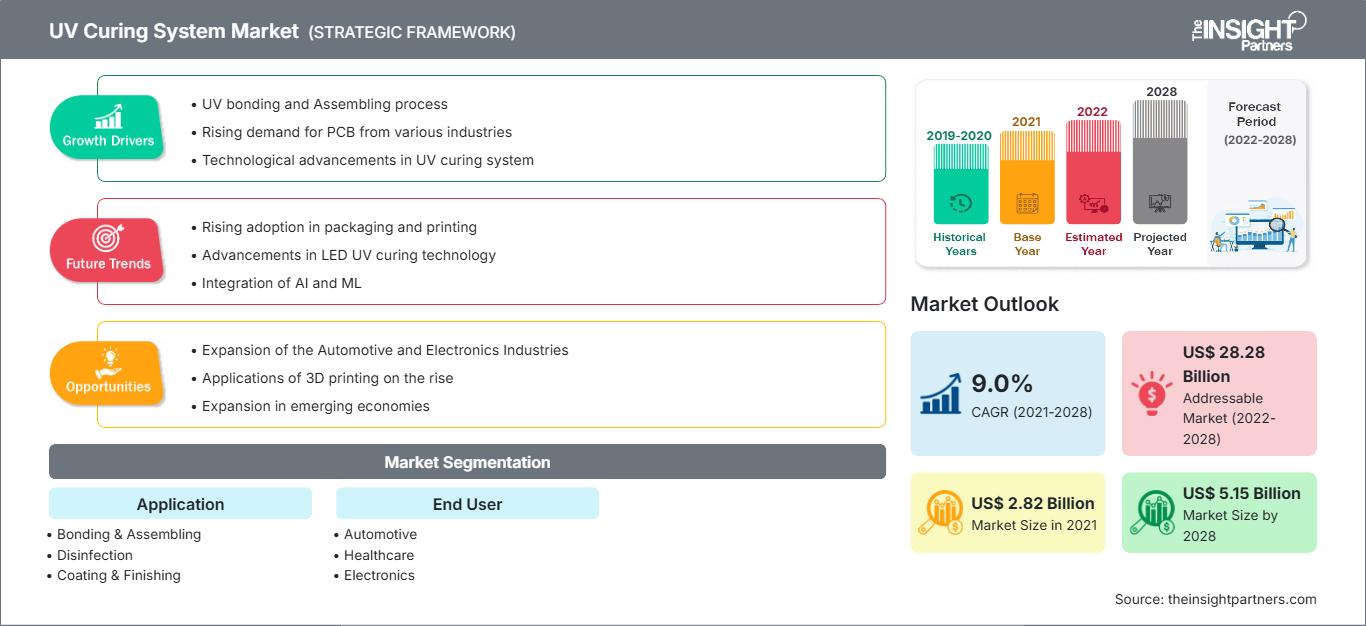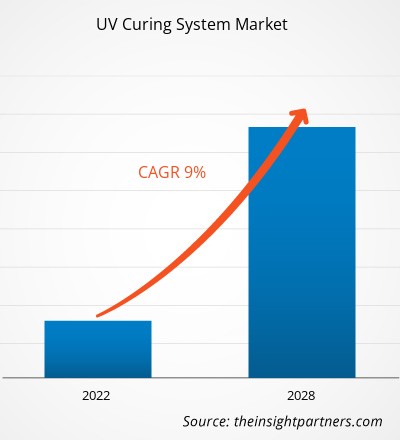Der Markt für UV-Härtungssysteme hatte im Jahr 2021 einen Wert von 2.817,2 Millionen US-Dollar und soll bis 2028 5.153,2 Millionen US-Dollar erreichen, mit einer CAGR-Wachstumsrate von 9,0 % im Prognosezeitraum von 2021 bis 2028.
UV-Härtung ist eine Methode zum Trocknen von Tinten, Klebstoffen und Beschichtungen. Das UV-Härtungssystem ist eine relativ alte Technologie und wird schon seit langer Zeit verwendet. Die alten UV-Härtungssysteme verwendeten Quecksilberlampen zum Aushärten. Mit dem technologischen Fortschritt und den zunehmenden Auswirkungen von Quecksilberlampen auf Arbeiter und Umwelt werden jedoch UV-LEDs als Quelle in den Härtungssystemen verwendet. Das Härtungsverfahren wird in vielen Branchen eingesetzt, beispielsweise in der Automobilindustrie, im Gesundheitswesen, in der Elektronik, in der Luft- und Raumfahrt, in der Grafik- und Kunstindustrie sowie bei Holzbeschichtungen. Mit der steigenden Nachfrage nach Klebe- und Montage, Drucken, Beschichten und andere Prozesse in den genannten Branchen. Die Nachfrage nach Systemen wird weiter steigen, was wiederum das Wachstum des Marktes für UV-Härtungssysteme fördern wird.
Zu den wichtigsten Akteuren im globalen Ökosystem des Marktes für UV-Härtungssysteme gehören Komponentenhersteller, Hersteller von UV-Härtungssystemen, Regierungsbehörden und Aufsichtsbehörden sowie Endverbraucher. Komponenten- und Hardwareanbieter bieten den Herstellern von UV-Härtungssystemen zahlreiche Teile und Komponenten an. Jeder Einfluss auf diese Komponentenhersteller wirkt sich direkt auf die Hersteller von UV-Härtungssystemen aus, da der gesamte Produktionsprozess von der rechtzeitigen Lieferung der Komponenten abhängt. Die breite Lieferkette von UV-Härtungssystemen spielt eine große Rolle bei der Förderung des Wachstums von UV-Härtungssystemen und beeinflusst somit das Marktwachstum.
Passen Sie diesen Bericht Ihren Anforderungen an
Sie erhalten kostenlos Anpassungen an jedem Bericht, einschließlich Teilen dieses Berichts oder einer Analyse auf Länderebene, eines Excel-Datenpakets sowie tolle Angebote und Rabatte für Start-ups und Universitäten.
Markt für UV-Härtungssysteme: Strategische Einblicke

- Holen Sie sich die wichtigsten Markttrends aus diesem Bericht.Dieses KOSTENLOSE Beispiel umfasst Datenanalysen, die von Markttrends bis hin zu Schätzungen und Prognosen reichen.
Sie erhalten kostenlos Anpassungen an jedem Bericht, einschließlich Teilen dieses Berichts oder einer Analyse auf Länderebene, eines Excel-Datenpakets sowie tolle Angebote und Rabatte für Start-ups und Universitäten.
Markt für UV-Härtungssysteme: Strategische Einblicke

- Holen Sie sich die wichtigsten Markttrends aus diesem Bericht.Dieses KOSTENLOSE Beispiel umfasst Datenanalysen, die von Markttrends bis hin zu Schätzungen und Prognosen reichen.
Auswirkungen der COVID-19-Pandemie auf die Marktstudie zu UV-Härtungssystemen in der Region APAC
Die von mehreren Regierungen in der Region verhängten Beschränkungen zur Eindämmung der COVID-19-Ausbreitung während der ersten Zeit des Ausbruchs (1. Quartal 2020) haben den Produktionsprozess aufgrund der eingeschränkten Belegschaft in Branchen wie der Automobil- und Elektronikindustrie stark beeinträchtigt. Unterhaltungselektronik und Automobilindustrie sind die wichtigsten Sektoren, die zum Wachstum des Marktes für UV-Härtungssysteme in der Region beitragen. Aufgrund von Arbeitsplatzverlusten oder Gehaltskürzungen ist die Kaufkraft der Kunden erheblich gesunken. Die verringerte Kaufkraft wirkte sich auf die Verkäufe von Unterhaltungselektronik in der gesamten Region aus. Laut Automobilindustrieverbänden erlitt die indische Automobilindustrie im Jahr 2020 einen Tagesverlust von etwa 31.164 Millionen US-Dollar. Dem Weltwirtschaftsforum zufolge gingen die Autoverkäufe in China in der ersten Februarhälfte 2020 um 92 % zurück. Mit der Wiedereröffnung der Volkswirtschaften und der Aufnahme des Betriebs in der Industrie stieg jedoch auch der Bedarf verschiedener Endverbraucher an UV-Härtungssystemen allmählich an. Dank der Lockerung früherer Beschränkungen können Unternehmen nun mit einer hohen Belegschaft arbeiten. Der Rückgang der Industrieaktivitäten hat sich negativ auf den Markt für UV-Härtungssysteme ausgewirkt.
UV-Kleben und -Montage fördern das Wachstum des Marktes für UV-Härtungssysteme
UV-Kleben und -Montage ist ein Verfahren zum Verbinden von Glas, Metall und Kunststoff sowie zur Montage von Leiterplatten (PCB). Bei der Verbindung werden ultraviolettempfindliche Klebstoffe verwendet, die auf die Produkte aufgetragen und zum Aushärten der Energie von UV-Härtungslampen ausgesetzt werden. Durch die UV-Härtung ist der Prozess schneller, flexibler, langlebiger und umweltfreundlicher als andere Verfahren.
Die UV-LED-Härtungsmethode reduziert die Emissionen flüchtiger Verbindungen. Daher ist die Nachfrage nach UV-Härtungssystemen mit LED in verschiedenen Branchen gestiegen, was das Marktwachstum vorantreibt. Die begrenzte Tiefenhärtung kann jedoch das Wachstum des Marktes für UV-Härtungssysteme hemmen.
Die steigende Nachfrage nach Leiterplatten aus verschiedenen Branchen, wie der Elektronik- und Automobilindustrie, beeinflusst den weltweiten Anstieg der Leiterplattennachfrage. Hersteller von Unterhaltungselektronik und tragbaren Geräten wie Smartwatches mit Chips und flexiblen Sensoren sehen dank des Internets der Dinge (IoT) neue Perspektiven. Durchbrüche im Gerätedesign und in der Fertigungstechnologie wirken sich positiv auf die Leiterplattenproduktion weltweit aus. Somit treibt der Anstieg der Leiterplattenproduktion die Nachfrage der Hersteller nach Klebe- und Montageverfahren an. Darüber hinaus wird erwartet, dass die Nachfrage nach Glasverklebungen in Endverbrauchssektoren wie der Elektronik-, Möbel- und Transportindustrie steigt, was das Marktwachstum im Anwendungssegment UV-Verklebung und -Montage im Prognosezeitraum ankurbeln dürfte.
Das andere Segment des Marktes für UV-Härtungssysteme umfasst Lebensmittel und Getränke, Herstellung, Verpackung, Holz und mehr. UV-Härtungssysteme werden in diesen Anwendungen für verschiedene Zwecke wie Kleben und Montieren, Desinfizieren und Drucken verwendet. Die erweiterten Funktionen der UV-Härtungssysteme gegenüber herkömmlichen Härtungssystemen führen dazu, dass sich viele Unternehmen für dieses System als Härtungsmethode für schnelleres Trocknen entscheiden. Diese Gründe werden das Wachstum von UV-Härtungssystemen jetzt und in den kommenden Jahren unterstützen. Beispielsweise werden UV-Härtungssysteme in der Nahrungsmittel- und Getränkeindustrie zunehmend zur Desinfektion von kontaminiertem Grund- und Oberflächenwasser eingesetzt. Sie werden auch aktiv zur Behandlung von Nahrungsmitteln und Verpackungsmaterialien verwendet, die über Förderbänder laufen, um die Sicherheit des Produkts zu gewährleisten, bevor es den Endverbraucher erreicht. Diese Faktoren treiben die Nachfrage nach UV-Härtungssystemen in der Nahrungsmittel- und Getränkeindustrie seit Jahren voran. Darüber hinaus treibt die zunehmende Nutzung von UV-Härtungssystemen für Klebeanwendungen in der Holzindustrie aufgrund ihrer schnellen Trocknung das Marktwachstum weiter voran.
Markteinblicke auf Endverbraucherbasis
Basierend auf den Endverbrauchern ist der Markt für UV-Härtungssysteme in die Branchen Automobil, Gesundheitswesen, Elektronik und Sonstige unterteilt. In der Automobilindustrie wird die UV-Härtung hauptsächlich verwendet, um Lacke schneller zu trocknen und die Aushärtungsgeschwindigkeit zu erhöhen. Da die Lackier-/Trocknungskapazität der Automobilhersteller eine der größten Engpässe in den meisten OEM-Fertigungslinien und Karosseriewerkstätten darstellt, bietet die UV-Härtungstechnologie den Unternehmen ein hervorragendes zeitsparendes Verfahren. Dieses Verfahren wird in der Automobilindustrie auch in verschiedenen anderen Bereichen eingesetzt, beispielsweise zum Lackieren von Karosserien oder als Kratzschutzbeschichtung für Außen- oder Innenkomponenten, als Korrosionsschutzbeschichtung für Tanks oder Metallfedern, zum Entgraten von Kunststoffteilen, zum Siebdruck auf Glasscheiben und zum Auftragen von Klebstoffen auf Zierleisten oder Heckspoiler. So nutzt beispielsweise die Heraeus Holding die UV-Härtung für verschiedene Dienstleistungen im Automobilsektor. Es bietet Kostenvoranschläge für die UV-Härtung von Scheinwerfergläsern, Reflektorgehäusen, Karosserieteilen und Motorraumkomponenten. Dies erhöht den Einsatz der UV-Härtung im Automobilsektor. Daher wird erwartet, dass der Markt für UV-Härtungssysteme im Automobilsegment in den kommenden Jahren wachsen wird.
Die UV LED Curing Association, die American Coatings Association und die International LED-UV Association spielen eine einflussreiche Rolle im Ökosystem des Marktes für UV-Härtungssysteme. Der Ausbruch von COVID-19 hat das Wachstum des Marktes für UV-Härtungssysteme erheblich beeinträchtigt. Der Ausbruch beeinträchtigte die Unternehmensumsätze und die globalen Lieferketten aufgrund von Fabrikschließungen, vorübergehenden Grenzschließungen und Handelsbeschränkungen weltweit. Es wird jedoch erwartet, dass sich dieser Markt gut entwickeln wird, da sich die Situation wieder normalisiert.
Markt für UV-Härtungssysteme Regionale Einblicke
Die regionalen Trends und Faktoren, die dieMarkt für UV-Härtungssystemewährend des gesamten Prognosezeitraums wurden von den Analysten von The Insight Partners ausführlich erläutert. In diesem Abschnitt werden auchMarkt für UV-Härtungssysteme Segmente und Geografie in Nordamerika, Europa, Asien-Pazifik, Naher Osten und Afrika sowie Süd- und Mittelamerika.
Markt für UV-Härtungssysteme Berichtsumfang
| Berichtsattribut | Einzelheiten |
|---|---|
| Marktgröße in 2021 | US$ 2.82 Billion |
| Marktgröße nach 2028 | US$ 5.15 Billion |
| Globale CAGR (2021 - 2028) | 9.0% |
| Historische Daten | 2019-2020 |
| Prognosezeitraum | 2022-2028 |
| Abgedeckte Segmente |
By Anwendung
|
| Abgedeckte Regionen und Länder | Nordamerika
|
| Marktführer und wichtige Unternehmensprofile |
|
Markt für UV-Härtungssysteme Spielerdichte: Ihre Auswirkungen auf die Geschäftsdynamik verstehen
DieMarkt für UV-Härtungssysteme Der Markt für digitale Produkte wächst rasant, angetrieben durch die steigende Endverbrauchernachfrage aufgrund von Faktoren wie sich verändernden Verbraucherpräferenzen, technologischem Fortschritt und einem stärkeren Bewusstsein für die Produktvorteile. Mit der steigenden Nachfrage erweitern Unternehmen ihr Angebot, entwickeln Innovationen, um den Bedürfnissen der Verbraucher gerecht zu werden, und nutzen neue Trends, was das Marktwachstum weiter ankurbelt.

- Holen Sie sich die Markt für UV-Härtungssysteme Übersicht der wichtigsten Akteure
Akteure auf dem Markt für UV-Härtungssysteme verfolgen Strategien wie Fusionen, Übernahmen und Marktinitiativen, um ihre Position auf dem Markt zu behaupten. Einige Entwicklungen der wichtigsten Akteure sind unten aufgeführt:
- Rich Bennett, Präsident von AMS Spectral UV, kündigte die Rückkehr des Unternehmens nicht nur als Gründer, sondern auch als Platin-Sponsor von Print UV 2022 vom 16. bis 18. März im Wynn Encore an.
- Phoseon Technology gab eine Partnerschaft mit American Ultraviolet zur Weiterentwicklung der LED-Härtung in allen UV-Härtungsmärkten bekannt.
Der globale Markt für UV-Härtungssysteme ist nach Anwendung und Endbenutzer segmentiert. Basierend auf der Anwendung ist der Markt in Kleben und Montieren, Desinfektion, Beschichten und Veredeln sowie Drucken unterteilt. Basierend auf den Endverbrauchern ist der Markt für UV-Härtungssysteme in die Bereiche Automobil, Gesundheitswesen, Elektronik und andere segmentiert.
American Ultraviolet, AMS Spectral UV, Dymax Chemical (Shanghai) Co. Ltd, Excelitas Technologies Corp., Hanovia-uv, Heraeus Holding GmbH, Jenton Group, Nordson Corporation und Phoseon Technology gehören zu den wichtigsten Akteuren auf dem Markt für UV-Härtungssysteme, die für die Forschungsstudie berücksichtigt wurden. In diesem Forschungsbericht wurden außerdem mehrere Akteure analysiert, um einen ganzheitlichen Überblick über den globalen Markt für UV-Härtungssysteme und sein Ökosystem zu erhalten.
- Historische Analyse (2 Jahre), Basisjahr, Prognose (7 Jahre) mit CAGR
- PEST- und SWOT-Analyse
- Marktgröße Wert/Volumen – Global, Regional, Land
- Branchen- und Wettbewerbslandschaft
- Excel-Datensatz
Aktuelle Berichte
Erfahrungsberichte
Grund zum Kauf
- Fundierte Entscheidungsfindung
- Marktdynamik verstehen
- Wettbewerbsanalyse
- Kundeneinblicke
- Marktprognosen
- Risikominimierung
- Strategische Planung
- Investitionsbegründung
- Identifizierung neuer Märkte
- Verbesserung von Marketingstrategien
- Steigerung der Betriebseffizienz
- Anpassung an regulatorische Trends






















 Kostenlose Probe anfordern für - Markt für UV-Härtungssysteme
Kostenlose Probe anfordern für - Markt für UV-Härtungssysteme